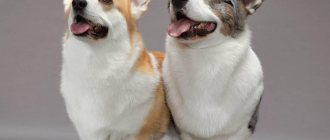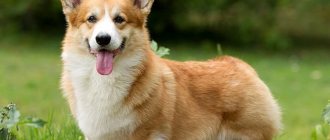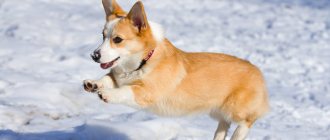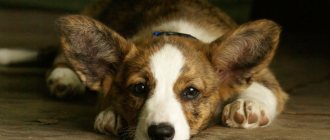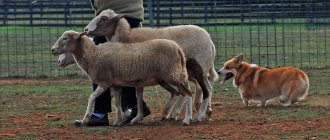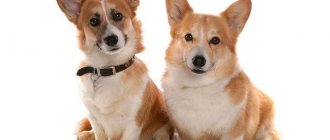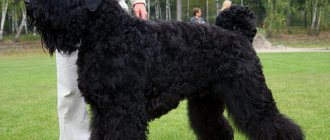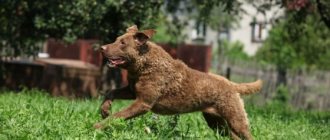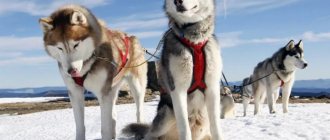What should be the weight and dimensions of a Welsh Corgi?
Amazing small dogs with an attractive appearance have conquered many human hearts. It’s not for nothing that corgis are Her Majesty’s favorite dogs. Despite her smiling appearance, cheerful temperament, the role of “darling of fate” turns out to be deceptive. In fact, Welsh Corgis are working dogs and were bred to herd livestock. They are called a miniature version of the German Shepherd. Therefore, representatives of the breed must always be in athletic condition - they cannot be overfed.
This article will be a source of useful information about what height and weight indicators should be, how to recognize obesity and how to combat it.
Description and varieties of the breed
The breed standard for the Cardigan Welsh Corgi, approved by the FCI, appeared in 1987. According to the description, representatives of the Corgi breed belong to the group of shepherd dogs without working tests.
- General impression of the dog: strong build, somewhat elongated body. The structure of the head is similar to that of a German Shepherd. The skull is wide and flat, the transition from the forehead to the muzzle is clearly defined. The corgi has a “fox” muzzle, quite long, tapering towards the nose.
- The eyes are dark, blue or blue, depending on the color of the dog.
- The ears are wide set, very large, rounded at the tips.
- The nose is large and black.
- Lips are dry and tight-fitting. Scissor bite, strong and developed teeth.
- The neck is muscular and well developed.
- The body is long, strong, the chest is rounded and deep, the loin is straight.
- The limbs are short, strong and muscular.
- The tail is long, similar to a fox's, and set high.
The FCI breed standard for the Pembroke Welsh Corgi was approved in 2010. According to it, the breed belongs to the first group - shepherd dogs without working tests.
- General appearance: the dog is small in stature, very strong and resilient.
- The head is distinguished by a wide and flat skull between the ears, narrowed closer to the nose, similar to a fox.
- The eyes are round, dark in color.
- The nose is black and large.
- The ears are medium in size, erect, slightly rounded at the tips.
- The jaws are strong, the bite is scissor-shaped, the lips are dry.
- The neck is long and muscular.
- The body is of medium length, the chest is very wide and deep, sloping well over the forelimbs, the back is level.
- The limbs are short and straight, strong and flexible.
- The tail is short from birth, docked or long foxtail. Is in line with the top.
brief information
Welsh Corgis are usually divided into two varieties: Pembroke and Cardigan. They differ from each other in size - Pembrokes are smaller, have different head shapes and the structure of the forelimbs. The head of the cardigan is coarser and more voluminous. The back is smooth, strong, durable. The placement of the front legs follows the shape of the sternum, which makes them more mobile dogs. This plays a role when working with livestock.
Pembrokes have a fox-like expression, and the black pigmentation of the lips against the background of the light head creates a “smile” effect.
Recently, the trend in commercial breeding has become higher, so the dog population has noticeably deteriorated. Males of larger size and weight than normal have become more noticeable. Such representatives of the breed now have a larger, more massive sternum and head, but the legs remain invariably short. Dogs become less maneuverable and mobile, and their working qualities deteriorate. The worst thing is that the risk of developing diseases associated not only with the musculoskeletal system increases.
Raising and training a corgi
The Corgi is a herding dog and is the smallest shepherd in the world. In terms of intelligence, she is no different from a German Shepherd, very smart, easy to train, and enthusiastically follows commands.
The basics of training are common to both types:
- For all their intelligence, corgis cannot think and analyze like people. Therefore, the owner needs to stoop to the dog’s level in order to explain to the pet what is required of it. This does not mean that a person should get up on all fours and bark; the owner’s responsibilities include the ability to think like a dog.
- Contact with your pet is the most important factor regarding training. The more motivated the corgi is to the owner, the greater the chances of getting a perfectly controlled dog.
- “From simple to complex” is the motto of all dog handlers. First, the dog develops conditioned reflexes, only then they begin to develop a behavioral repertoire.
Here the training path diverges: Cardigans go their own way, Pembrokes go theirs.
Cardigans have a more developed desire to serve their owner, provided the dog respects him. They are ready to work day and night, as long as the training is positive and they like it. Representatives of the breed are trained using positive reinforcement, but with a minimum of mechanical intervention. As a small shepherd, the Corgi breed is very smart.
Pembrokes are more independent, they have excellent concentration and endurance. Training in the form of a game is an ideal option for shortbreads. A toy is used as positive reinforcement, since a treat can do a bad job. “Chanterelles” are also those gluttons who know how to look so hungry and unhappy that the owner’s hand reaches out for an additional tasty piece.
Important! Both breeds do not tolerate moral and physical pressure. A dog will no longer respect an owner who tries to force it to work.
Welsh Corgi weight and height table
The dog's weight and height should be in harmony with each other. Let's find out what these indicators should be. What is considered normal and what is not?
Puppies up to a year
The approximate body weight of puppies up to one year is presented in the table.
| Age | Weight, kg | Height, cm |
| 1 Week | Approximately 0.5 | = |
| 2 week | 0,7 | = |
| 3 week | 1,0 | = |
| Month | 1,2-1,9 | 8-10 |
| 2 months | 2,8-4,0 | 8-10 |
| 3 months | 5,0-6,0 | 13 |
| 4 months | 7,0-8,0 | 16 |
| 5 months | 8,0-9,0 | 21 |
| 6 months | 9,0-10 | 24 |
| 7 months | Adult body weight | 26 |
| 8 months | Did not change | 30 |
The period of active growth of a puppy occurs from 4 to 6 months. This is the time when the dog’s diet should contain the optimal ratio of vitamin D and calcium for the proper formation of the musculoskeletal system.
At about six months, the puppy may experience some thinness, because the reserves of nutrients are spent on the formation of bones, ligaments, joints and the replacement of teeth. After six months the animal gains weight and becomes well-fed.
At about seven months of age, the period of active growth stops. The rib cage finishes forming and begins to gain volume. The puppy's coat changes, the “baby fluff” comes off, and the dog acquires a new, “adult coat.”
Dosed, moderate physical activity is important for a growing puppy. You should not overload the musculoskeletal system, because health problems may arise in the future. Short games with a toy and a short run at a light trot are the most suitable training for your baby.
Adults
According to the division of the breed into varieties, different standards have been developed:
- Cardigan: weight of males – 13-17 kg, weight of females – 11-15 kg;
- Pembroke: weight of males – 10-11 kg, weight of females – 10-13 kg;
Size and weight
The height of the Pembroke Welsh Corgi varies between 25 and 30 centimeters . The weight of a male dog is 10-12 kg. , females are lighter - from 9 to 11 kg . Cardigan Welsh Corgis are slightly taller. The size of an adult corgi dog starts at 27 cm, the upper height limit is 32 cm.
Adult corgi dog weight:
- males from 13 to 19 kg.
- females - from 11 to 13 kg.
Color and coat type
The color of the Cardigan Welsh Corgi is varied. They can be red and white, piebald (brindle with white markings), sable, tricolor, brindle (brindle) and blue merle (merle). Black-headed corgis are occasionally found; their main color is black and white.
Pembrokes have a less varied coat color: red, sable, yellow-brown, dark and tan (tri-color). Black and white corgis are not found among representatives of this breed.
The structure of the coat is dense, with a thick undercoat in both species. There are no dwarfs among corgis . Dwarf corgis are an invention of breeders in order to sell non-purebred puppies for a large sum.
What affects weight and height
There are many factors that influence a dog's height and weight. It is recommended to purchase a puppy after receiving two vaccinations - at about three months.
Full vaccination is important to ensure that the baby is protected from viral infections. In addition, before vaccination, the animal must undergo deworming.
A puppy infected with helminths is more susceptible to diseases of various etiologies. In children, the digestive system does not work well, food is digested worse, there is a disorder in the intestinal tract, and there is also a noticeable delay in development.
Once you have a pet, it is recommended to feed it its usual food for about ten days. You can't change your diet suddenly. This will trigger the development of diarrhea, which is difficult to stop in puppies. Losing stool will cause weight loss.
It is necessary to feed the puppy a balanced diet and frequent but small portions. A four-month-old Corgi should eat 10% of its body weight in food.
The daily volume of feed is divided into several parts. Small meals will help the proper absorption of food, which means that the puppy will gain kilograms faster, develop rapidly, and grow. A healthy baby will be active, cheerful and energetic.
When eating natural food or middle-class food, the dog requires multivitamin complexes. They can be purchased at a veterinary pharmacy, where they are sold according to the age of the pet.
Not only proper nutrition, but also daily walks in the fresh air will help you raise a strong, healthy four-legged friend. Moderate physical activity helps build muscle mass.
A dog's height and weight are influenced by genetic factors. If there is a predisposition to problems with excess weight or the musculoskeletal system, then the baby runs the risk of inheriting these features.
Obesity in pets
Excess weight not only spoils the appearance, but also significantly worsens the health of your four-legged friend. Causes of obesity include metabolic diseases, genetic predisposition, a sedentary lifestyle and poor diet. Residential dogs are often affected.
Spayed female dogs often become predisposed to gaining excess weight. Disturbed hormonal levels provoke obesity
Up to a certain point, owners may be amused by the rounded shape of the Welsh Corgi, but excess weight is a colossal burden on the dog’s body. If you do not start the fight against extra pounds in a timely manner, obesity will set in - a real problem that leaves a negative imprint on the dog’s life and well-being.
Obesity contributes to the development of dangerous diseases that are often irreversible: diabetes mellitus, pathologies of the cardiovascular system. Don't forget about problems with the spine and joints that occur in overweight dogs. Therefore, you can’t risk your pet’s health; you need to start fighting excess kilograms in a timely manner!
How do you know if your body weight is normal? The most important criterion is the breed standard - the numbers are clearly written there. In addition to official indicators, you need to focus on your own animal, because... Every dog's body is different. Feel your pet's ribs - at a normal weight, they are easy to feel.
Also, in a non-obese dog, the ribs will protrude above the level of the abdomen when lying down. If you are overweight, it is difficult to see the respiratory movements of the chest.
Associated symptoms are shortness of breath, fatigue, and decreased performance.
The most important question: what to do? Bring your pet to the veterinarian. The specialist will conduct a thorough examination, prescribe, if necessary, examinations or tests, a special diet and advise the correct physical activity.
A suitable diet program is a key point in the fight against the worst enemy of a slim figure. The selected diet for an overweight dog is used to improve metabolism, lose weight, and strengthen the immune system. It is important to follow the veterinarian’s recommendations, follow a diet and prohibit family members from feeding the animal “delicacies”!
Physical activity is selected according to the individual characteristics of the corgi. Based on the condition and weight of the animal, the doctor prescribes an appropriate training program. It is important to increase the load gradually, listening to your own dog.
Brief history of origin
The breed appeared several centuries ago. This is evidenced by excavations at the site of a settlement that existed at the turn of the 8th-9th centuries. Among the numerous finds of archaeologists, the remains of a small dog were discovered, similar to the current representatives of the breed.
Interesting! In the 10th century, the Welsh king Hywel the Good issued a decree according to which for the murder of a shepherd Welsh Corgi, the owner had the right to receive a whole ox as compensation.
Mini Shepherds are believed to be descended from Lundehunds or Swedish Vallhunds. The breed has much in common with both. Mini-shepherds were used not only for herding sheep, but also for looking after herds of ponies.
And when Welsh farmers began to actively raise poultry, dogs of this breed began to help drive geese and ducks to city markets.
The official presentation of the breed took place at an exhibition in England in 1925. Until 1934, Welsh Corgis were not divided into Pembrokes and Cardigans. But after
The UK Kennel Club has recognized that they are two different breeds. At the same time, to visually indicate the difference between the Cardigan and the Pembroke, they decided to dock the tail of the latter.
Skinny Welsh Corgi
Prominent pelvic iliac tubercles in a dog are a sign of underweight. Problems with the digestive system can be judged by your pet's dull, tousled fur.
To gain weight or cure advanced thinness, it is recommended to go to a veterinarian. In the early stages, the owner can cope on his own: just increase the protein content in the diet and divide the feeding into four meals. This approach should help you regain your optimal weight within a month. If you cannot correct the current situation, it is better to consult a doctor. Perhaps the cause of underweight is a serious illness.
Optimal nutrition
At the stage of choosing a future pet, a person must clearly understand that he will have to feed it with high quality. Feed! And this concept does not hide feeding cutlets, sausages, sausages or other delights from the master’s table. The dog must receive proper, balanced nutrition.
A well-designed menu is a guarantee of the dog’s health and well-being, and also that you will not be a regular visitor to veterinary clinics.
Whether or not to prepare natural food for your pet daily is the owner’s decision. Not everyone has enough time to cook. Most people prefer ready-made commercial feed.
The owner’s main task is to choose high-quality food: premium or super-premium.
You can determine if food is suitable or not based on the following criteria:
- The pet looks great;
- Excellent wool;
- There are no stool abnormalities;
- Doesn't bother your ears;
- There are no skin diseases;
- No discharge from the eyes;
- Normal weight.
If the indicators coincide with reality, then you are incredibly lucky. They don’t look for good from good - don’t change the brand unless absolutely necessary.
When using dry food, it is necessary that the dog always has access to drinking water. Under the influence of liquid, the granules swell in the stomach, increasing in size. Actually, for the same reason, you should not leave a bag of pet food within reach.
Maintenance and care
The Pembrock Welsh Corgi is an unpretentious dog. She gets along outside the city and in a noisy metropolis. The pet is suitable even for a one-room apartment, subject to long and energetic walks.
Pembrokes tolerate cold well, but heat a little worse. But keeping them in an enclosure and, especially, on a leash is impossible. These are companions, they need to constantly be close to people and communicate with them.
Grooming
The Corgi dog breed is one of the easiest to care for. Need to:
- comb the dog once every 3-4 days, daily during a coat change;
- trim nails every week;
- remove nitrous oxide from the eyes every day;
- remove dirt and wax from ears twice a week;
- Brush your teeth every 3-4 days.
Pembrokes shed heavily in the fall and spring—hair will be on floors, carpets, and sofas. When changing coats, they are combed out with a slicker brush, the rest of the time with a long-toothed comb and a massage brush.
Bathing
Pembroke Welsh Corgis are clean. They have a waterproof undercoat and a dirt-repellent coat. They are bathed as needed, but not more than 2 times a month. Use hypoallergenic zoo shampoo - it must be thoroughly washed out of the thick, dense coat.
Due to their short stature, Pembrokes collect dirt with their stomachs. After each walk, be sure to wash your paws, chest, and belly with clean water without soap. To prevent corgis from getting too dirty, they are dressed in protective overalls in the slush.
The thick coat of the Welsh Corgi takes a long time to dry. They should not be taken outside for 3-5 hours after bathing.
Walk
Pembroke Welsh Corgi dogs are active and athletic. They love long walks, running, and games that require a lot of work with their paws and head.
It’s good if the Pembroke lives in a private house - he will partially release his energy by running around the fenced yard. In this case, joint walks with the owner can be reduced to 1-2 hours a day. Apartment residents will have to make up for this difference by spending 3-4 hours outside every day.
Feeding
The Welsh Corgi dog loves to eat. Overeating is a major problem for Pembrokes. They constantly beg for tidbits and pretend to be dying of hunger, even if their stomachs have already sagged to the floor. Their nutrition is controlled. Excess weight has a bad effect on the corgi's already problematic joints and vertebrae.
The rest of the diet of the Pembroke Welsh Corgi is standard. They are fed natural food with a high meat content or holistic or super-premium food. Most owners prefer ready-made products - this makes it easier to keep track of the balance of the menu and the volume of portions.
Important Tips
A few important recommendations:
- The owner must understand that the dog eats food when it is hungry. If a pet runs happily, jumps, plays, but refuses to eat, you cannot force him to eat or persuade him, beg him, punish him for poor appetite;
- Train your dog to eat a portion of food quickly. A healthy animal eats food in five minutes. It is impossible for a pet to choose, chew for a long time or leave food and finish eating after half an hour;
- The owner must develop strong eating behavior in the dog. After putting the food in the bowl, offer it to your pet. If he sniffs and leaves, remove the cup. When the dog returns, he will realize that there is no food - he will remain hungry. Next time you experience the same behavior, repeat the steps. Sooner or later the dog will learn to eat the portion quickly;
- A puppy at 2-4 months should look well-fed - not thin or fat. After four months, the corgi will lose excess weight and begin to acquire the forms corresponding to an adult. Next, the dog should be in a dry condition. Excess weight is inappropriate here. This is important for the proper formation of the ligamentous, muscular and bone apparatus;
Proper, balanced nutrition is the key to the health of your four-legged friend!
